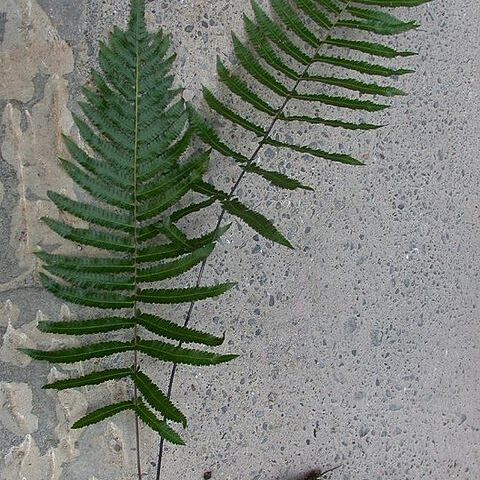Stems long-creeping to ascending to erect, 1.5--12 mm or more diam. Blades 1-pinnate to pinnate-pinnatifid, rarely 2-pinnate, proximal pinnae reduced or not, apex commonly gradually reduced, infrequently abruptly reduced and pinnalike; pinnae entire to deeply pinnatifid, sessile or short-stalked; costae grooved adaxially; buds absent or uncommonly present in axils of pinnae; veins free to regularly anastomosing, commonly simple (1-forked in a few species, e.g., Thelypteris palustris ) and reaching margin; indument various abaxially, often of simple or branched hairs on blades, rachises and costae with or usually without scales. Sori round, oblong, or elongate along veins, commonly medial to supramedial; indusia round-reniform, large (ca. 1 mm diam.) and persistent or sometimes small (less than 0.3 mm diam.), occasionally ephemeral, sometimes absent; sporangial capsules glabrous or occasionally hairy. x = 27, 29, 31, 32, 33, 34, 35, 36.
Petiole stramineous, with 2 bundles that unite below the blade; lvs bipinnatifid or pinnate-pinnatifid, sparingly or not at all scaly, pubescent with acicular, unicellular hairs, at least on the upper side of the rachis, often also on the costae; rachis grooved, the marginal ridges continuous, elevated above the insertion of the costae; veins free, reaching the margins, running into the teeth (if present); sori intramarginal, each borne on a vein that continues to the margin; indusium when present small and inconspicuous, hyaline, often ciliate and/or glandular, reniform or horseshoe-shaped, attached at the sinus on the basipetal side of the sorus, or in some spp. wholly wanting; medium-sized wood-ferns with scattered, thin, light green, deciduous lvs and long, slender, blackish, sparingly (seldom densely) scaly rhizomes. 500+, cosmop.
Rhizome dictyostelic, paleate; lamina us. pinnate, sts setose; veins all free or the lowest of adjacent segs uniting at or near sinus. Sori dorsal, us. small; indusium reniform-cordate or absent; spores bilateral. Copeland (Gen. Fil. 1947, 136) as against Alston (Kew Bull. 1932, 309) argues that Thelypteris Schmidel is invalid, and that Lastrea Bory, 1824, should be adopted.
Rhizome long-creeping, in wet ground; fronds simply pinnate with deeply lobed pinnae, basal ones not reduced; veins free, usually forked, all reaching margin; flat thin scales present on lower surface of costae; sori indusiate; sporangia bearing short capitate hairs; perispore of spores varied (see A.F. Tryon Rhodora 73 1971 444 ).
Rhizome long-creeping, slender. Fronds 1-pinnate; pinnae deeply lobed; basal pinnae not or little reduced; lower surface of costae with flat thin scales; veins free, usually forked, all reaching the margin. Sori indusiate; sporangia bearing short capitate hairs near the annulus. Spores variable.

